The Ultimate Guide to Kawaii Pictures: From Origins to Modern Trends

What Are Kawaii Pictures?
Kawaii pictures are a quintessential aspect of Japanese pop culture, characterized by their cute, charming, and often childlike appearance. The term “kawaii” translates to “cute” in Japanese, and these images usually feature adorable characters with exaggerated features, such as large eyes and small bodies. The appeal of kawaii pictures extends beyond mere aesthetics; they embody a broader cultural phenomenon that emphasizes innocence and cuteness in various forms of media.
2. Historical Context
Origins of Kawaii Culture
The roots of kawaii culture trace back to the post-war era in Japan, where societal changes and economic growth led to the rise of youth culture and fashion. In the 1970s, the word “kawaii” began to be used more frequently to describe the cute and youthful aesthetic that was becoming popular. Over time, this cultural trend expanded into various media, including art, fashion, and entertainment, solidifying its place as a major cultural force.
3. Popularity of Kawaii Pictures
Influence of Japanese Pop Culture
Kawaii pictures gained international fame through the global reach of Japanese pop culture. Anime and manga, two of the most influential Japanese media forms, frequently feature kawaii characters, which has contributed significantly to the spread of this aesthetic worldwide. Additionally, kawaii culture has been embraced by international brands and artists, further popularizing these images.
4. Elements of Kawaii Pictures
Key Visual Features
Kawaii pictures are defined by several key visual elements. These include:
- Exaggerated Features: Large eyes, small mouths, and round faces are common traits.
- Bright Colors: Soft pastels and vibrant hues enhance the cuteness factor.
- Simple Shapes: The use of basic geometric shapes helps in creating approachable and easy-to-recognize characters.
- Expressive Faces: Emotions are often depicted in an exaggerated, straightforward manner to convey feelings clearly.
5. How to Create Kawaii Pictures
Tools and Techniques
Creating kawaii pictures involves a blend of artistic tools and techniques. Here are some steps to get started:
- Sketching: Begin with simple pencil sketches to outline your character.
- Inking: Use fine liners or digital tools to outline your sketches.
- Coloring: Apply vibrant colors using markers, colored pencils, or digital software.
- Shading and Highlights: Add depth with subtle shading and highlights, but keep it minimal to maintain the cute aesthetic.
6. Digital vs. Traditional Kawaii Art
Comparison of Mediums
Digital and traditional methods each offer unique advantages for creating kawaii art. Digital tools, such as graphic tablets and software like Adobe Illustrator, provide flexibility and precision, allowing for easy revisions and color adjustments. Traditional methods, including watercolor and markers, offer a more tactile experience and can produce unique textures that are hard to replicate digitally.
Read also: How to Start a Stationery Business in Dubai
7. Kawaii Art in Fashion
Integration into Apparel and Accessories
Kawaii art has made significant inroads into the fashion industry. From clothing and accessories to home decor, the influence of kawaii aesthetics is evident. Popular items include t-shirts with cute character prints, pastel-colored accessories, and even kawaii-themed home furnishings. This integration helps in spreading the charm of kawaii culture to a broader audience.
8. Kawaii Pictures in Media
Use in Anime, Manga, and Video Games
Kawaii characters are a staple in anime, manga, and video games. These media often use kawaii aesthetics to create engaging and relatable characters. Iconic figures like Hello Kitty and Pikachu exemplify how kawaii designs can become cultural icons, bridging the gap between entertainment and consumer products.
9. Kawaii Pictures for Branding
Impact on Marketing and Advertising
Brands have increasingly adopted kawaii imagery to appeal to a younger demographic and evoke a sense of warmth and friendliness. The use of cute characters in marketing campaigns helps create a positive brand image and attract consumers by leveraging the emotional appeal of kawaii visuals.
10. The Psychology Behind Kawaii
Emotional and Psychological Appeal
The psychological appeal of kawaii pictures lies in their ability to evoke feelings of happiness and comfort. The exaggerated features and simple forms are designed to trigger a nurturing response, akin to how people respond to baby animals or young children. This emotional connection enhances the appeal of kawaii art across various contexts.
11. DIY Kawaii Art Projects
Step-by-Step Tutorials
For those interested in creating their own kawaii art, here are a few DIY project ideas:
- Kawaii Stickers: Design and print stickers featuring cute characters.
- Custom Plushies: Sew plush toys based on your kawaii designs.
- Kawaii Greeting Cards: Create handmade cards with kawaii illustrations for special occasions.
12. Popular Kawaii Artists
Profiles of Notable Creators
Several artists have gained recognition for their contributions to kawaii art. Notable figures include:
- Yoshitomo Nara: Known for his distinctive, childlike characters.
- Kiki and Lala (Sanrio): Creators of iconic characters like Little Twin Stars.
- Takashi Murakami: Blends kawaii aesthetics with contemporary art.
13. Kawaii Art Trends
Emerging Styles and Innovations
Kawaii art continues to evolve, with new trends emerging regularly. Current trends include:
- Neo-Kawaii: A modern twist on traditional kawaii, incorporating elements of surrealism.
- Kawaii Minimalism: Simplified designs with a focus on minimalism and clean lines.
- Interactive Kawaii Art: Integration of kawaii characters into interactive media and digital platforms.
14. Future of Kawaii Pictures
Predictions and Emerging Trends
The future of kawaii pictures is likely to see further integration into virtual reality and augmented reality experiences. As technology advances, we can expect more immersive and interactive kawaii experiences that blend traditional charm with cutting-edge technology.
15. Conclusion
Summary and Final Thoughts
Kawaii pictures are more than just cute visuals; they represent a significant cultural phenomenon with a rich history and broad influence. From their origins in Japanese culture to their impact on global media and fashion, kawaii images continue to captivate audiences and inspire artists. Whether you’re a fan or a creator, understanding the elements and trends of kawaii art offers insight into this charming and dynamic aesthetic.



